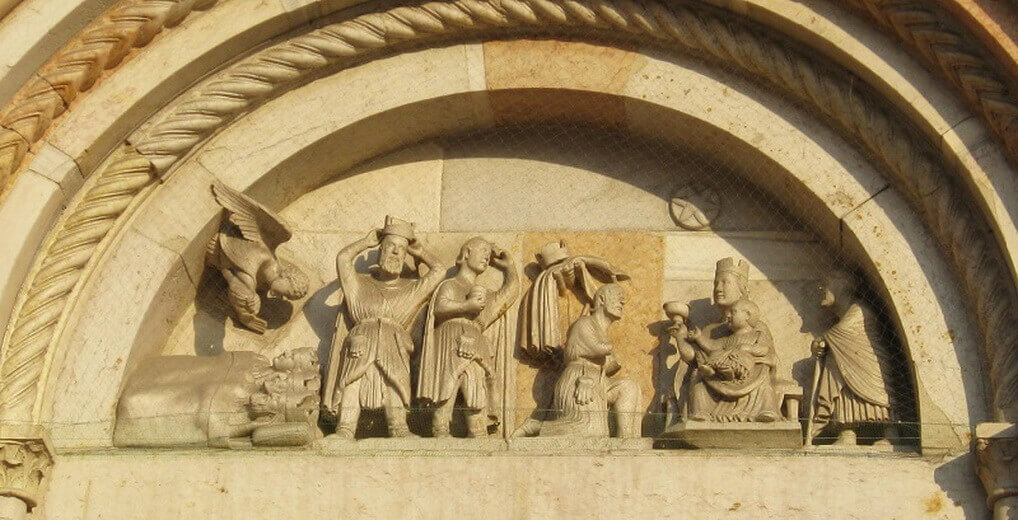
“Dream and Adoration of the Wise Men”, also known as Kings: a sculptural group of Master of the Months
This marble sculptural group, representing the Wise Men during the dream and adoration of the Christ Child, is a famous work of the Master of the Months. It is positioned on the lunette of the portal of San Mercuriale Abbey in Forlì; the dating is not certain but it is supposed that it dates back to the beginning of the 13th century. The figures, sculpted in depth with the high relief and undercut techniques, seem statues worked in the round; they are rich of details and some are only fruit of the imagination of the artist. For centuries it has been considered a mediocre work, only in the last decades it has been recognized as masterpiece, even if the opinions are very conflicting: some recognize the ability of the artist to represent an event rich in details in a reduced space, others underline the defects regarding proportions, logic and truth. In fact, the sculptor has told with poetry and imagination the beauty of a truth and the value of a dream; he has dared in an age in which the interpretation and the representation of the events were imposed from the Church.
Who was the Master of the Months?
Master of the Months is an anonymous Italian sculptor who worked in Ferrara, Forlì and Venice in the first half of the 13th century. In the history of the medieval art, the mystery around his identity always had a considerable charm. He was a follower of famous artists but he elaborated a personal style turning a lot of attention to the nature and description of the reality. He was named after a cycle of tiles representing the calendar months, sculpted with the figures of the twelve seasonal agricultural works that once decorated the Pilgrims Door of the Cathedral situated in Ferrara and today they are preserved in the Museum area.
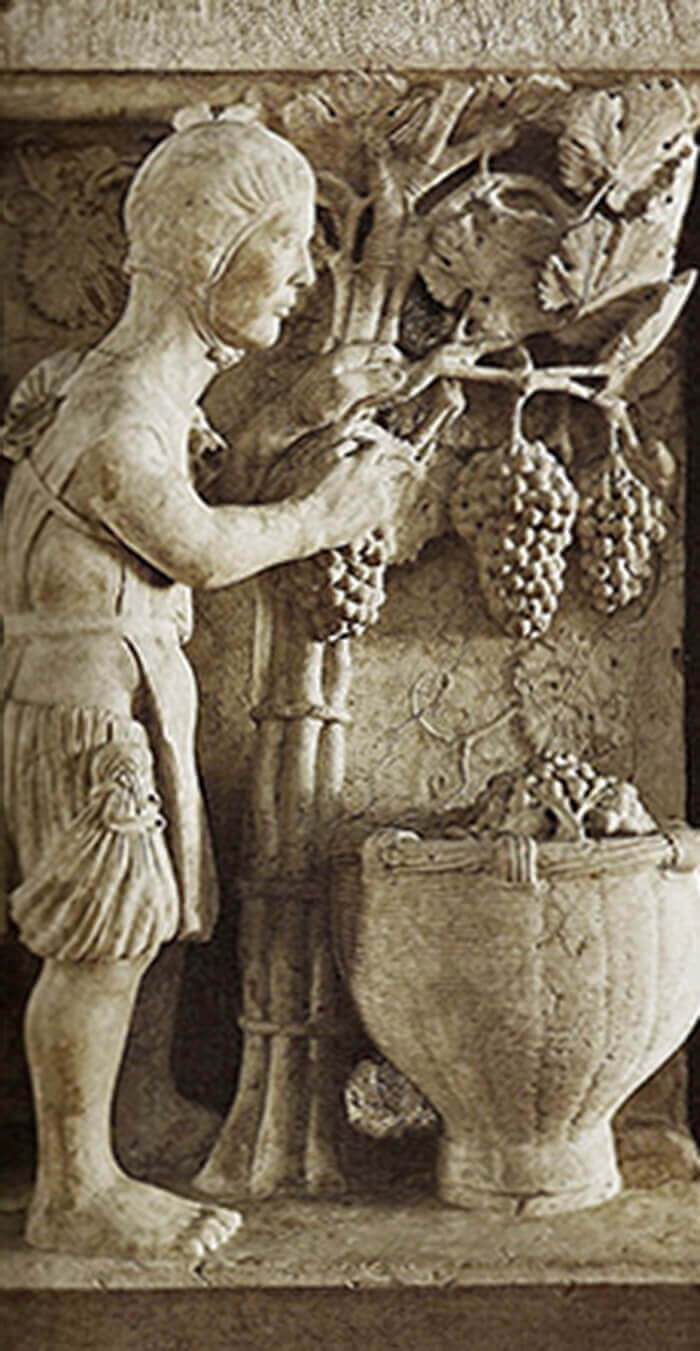
Thanks to these works, he also exceeded the master Benedetto Antèlami, considered one of the greatest artists of the 12th and 13th century who had sculpted in high relief a cycle of months to decorate the Cathedral of Parma.
What does the work named “Dream and Adoration of the Wise Men” represent?
The narration is divided in two different scenes represented in the temporal order from right to left:
Adoration
The Wise Men are represented in front of Christ child, from right to left, one after another, in spatial and temporal order; the scene seems to show, with subsequent frames, the order with which veneration is alternated. The first, kneeling in front of Mary, has already laid mantle and crown and seems to hand one of the gifts: gold, incense or myrrh; the interpretation is uncertain because the hands were lost. The other two are preparing themselves by taking off the crown from the head.
Dream
An angel appears in a dream to the Wise Men while they are asleep, encouraging them not to go to Herod to tell about the new King but to return home by a different way. In this scene, the artist has taken care of the details: the Wise Men are represented asleep, one next to each other, with the left hand resting on the face in order to make the image more realistic, with the head crowned also at night and they are rested on a unique pillow and under the same blanket of which the artist has also sculpted the pattern and the ample folded hem.
As described in the Gospel:
« After they had heard the king(Herod), they went on their way, and the star they had seen when it rose went ahead of them until it stopped over the place where the child was. When they saw the star, they were overjoyed. On coming to the house, they saw the child with his mother Mary, and they bowed down and worshiped him. Then they opened their treasures and presented him with gifts of gold, incense and myrrh. And having been warned in a dream not to go back to Herod, they returned to their country by another way. » (Matteo 2,9-12)
Which are the elements represented in the work?
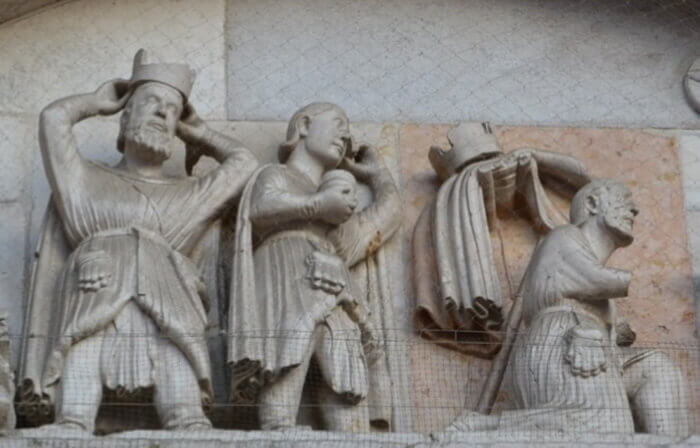
- The Wise Men: they were wise astronomers that from East, following a star, arrived at Jerusalem to adore Christ child, king of the Jews. In the foreground, they are strongly characterized in the Adoration with different faces: the first to the right has a short beard and an age that would seem median among that of the others, the second is hairless and seems to be the youngest, the third one on the left with a long and thick beard, seems the eldest of the three. In the Dream they are represented in secondary way on the left marginal side of the lunette.
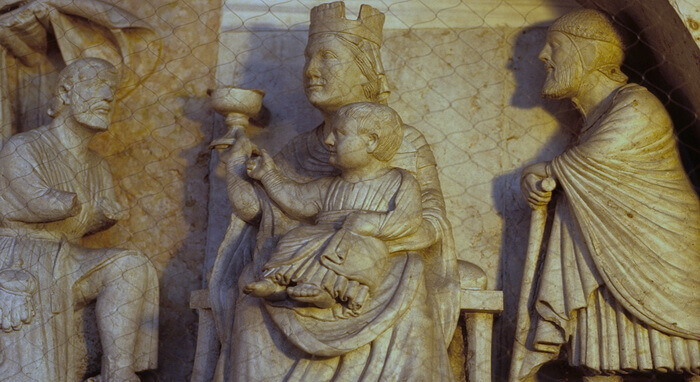
- Mary: is one of the main figures. She is represented like a queen, with the crown, seated on a throne that protrudes if compared to the plane of the lunette. She holds on the legs the Christ child. The gaze is not directed towards the Wise Men but seems to be lost into infinity with a light smile.
- Christ child: has classical features and reaches out his hand towards the chalice held by Mary.
- Joseph: is a hunched figure, smaller compared with others. He is positioned on the far right of the lunette and seems to have a secondary role of simple spectator.
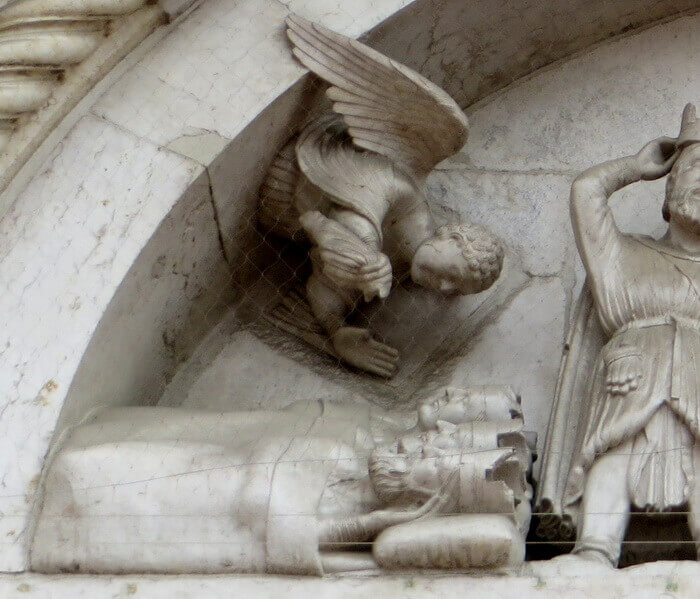
- The Angel: this figure is the most particular and the unique represented in half-bust. He has the head covered of curls, the wing meticulously engraved that comes out of the contour of the marble block, the left hand is outstretched towards the sleepers with the palm facing towards their faces.
- The six-pointed star: as shown by the engraving on the back, it is an ancient bas-relief previously sculpted. Probably it has been found among the remains of the old church, destroyed by the fire of 1173 and therefore recovered for the construction of the current one.
The celebration of the Epiphany reminds us a beautiful consideration of Pope Francis:
«We feel the Wise Men close to us, as fellow travelers. Their example help us to lift the gaze towards the star and to follow the great desires of our heart. We are taught not to be content with a mediocre life but to always let ourselves be attracted by what is good, real and beautiful. »
If you have any questions or curiosity on the subject please add a comment in the form below; every opinion will be a stimulus to compare notes and to continue the search for new in-depth analyses.
This article contains general information. For questions and curiosities leave a comment below. If you wish to be contacted, please fill out the form.



